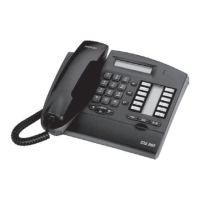THIRD PARTY CTI - CSTA APPLICATIONS
Ed. 042/16 Réf. 3EH 21000 BSAA
SOFTWARE ARCHITECTURE
The CSTA connection is made via a CSTA agent located in the system. The maximum number of si-
multaneous sessions is 28. The tasks performed by an agent are:
- management of connection with the CTI server
- ASN1 encoding/decoding of requests and events in compliance with ECMA 180
- recovery of telephone events for the monitored devices
- management of the connection between the telephone application and the system corresponding
to the service request from the CTI server
CSTA DIALOGUE
CSTA dialogue is built around the Client/Server model. Each party (system, computer server) can send
or reply to a service request and provide an event report.
CSTA MODEL
The CSTA standard makes the application independent of physical implementation of the switching
networks used. To do this, it provides the applications it addresses with an abstract view of the under-
lying telephone assembly. This abstraction is obtained by modeling the switching part. The generic mo-
del developed to represent the working of the telephone part is built around three notions:
The Device
This notion refers to:
- physical devices such as: telephone sets, circuit groups, lines,
- logical devices: groups, ACD.
- Device Type
CSTA defines several types of devices which can be handled or observed (ACD, operator, circuit
group, etc.).
- Device Class
The devices observed can belong to different families (data, image, voice, other)
- Device Identifier
The devices handled are referred to by a device identifier for the CSTA service. Depending on
whether or not the device is involved in a call, the identifier will be dynamic or static.
- Device State
This is a set of connection states linked to a particular device.

